Ultrasonographic and Histological Correlation after Experimental Reconstruction of a Volumetric Muscle Loss Injury with Adipose Tissue
Autor
Leiva-Cepas, Fernando
Benito‐Ysamat, Alberto
Jimena Medina, Ignacio
Jiménez-Díaz, Fernando
Gil‐Belmonte, María Jesús
Ruz‐Caracuel, Ignacio
Villalba, Rafael
Peña Amaro, J.
Editor
MDPIFecha
2021Materia
Muscle ultrasoundMuscle regeneration
Volumetric muscle loss
Adipose tissue
Muscle tissue engineering
METS:
Mostrar el registro METSPREMIS:
Mostrar el registro PREMISMetadatos
Mostrar el registro completo del ítemResumen
Different types of scaffolds are used to reconstruct muscle volume loss injuries. In this experimental study, we correlated ultrasound observations with histological findings in a muscle volume loss injury reconstructed with autologous adipose tissue. The outcome is compared with decellularized and porous matrix implants. Autologous adipose tissue, decellularized matrix, and a porous collagen matrix were implanted in volumetric muscle loss (VML) injuries generated on the anterior tibial muscles of Wistar rats. Sixty days after implantation, ultrasound findings were compared with histological and histomorphometric analysis. The muscles with an autologous adipose tissue implant exhibited an ultrasound pattern that was quite similar to that of the regenerative control muscles. From a histological point of view, the defects had been occupied by newly formed muscle tissue with certain structural abnormalities that would explain the differences between the ultrasound patterns of the normal control muscles and the regenerated ones. While the decellularized muscle matrix implant resulted in fibrosis and an inflammatory response, the porous collagen matrix implant was replaced by regenerative muscle fibers with neurogenic atrophy and fibrosis. In both cases, the ultrasound images reflected echogenic, echotextural, and vascular changes compatible with the histological findings of failed muscle regeneration. The ultrasound analysis confirmed the histological findings observed in the VML injuries reconstructed by autologous adipose tissue implantation. Ultrasound can be a useful tool for evaluating the structure of muscles reconstructed through tissue engineering.
Fuente
International Journal of Molecular Sciences 22(13), 6689 (2021)Versión del Editor
http://dx.doi.org/10.3390/ijms22136689Ítems relacionados
Mostrando ítems relacionados por Título, autor o materia.
-
Absolute and Relative Reliability of the Assessment of the Muscle Mechanical Properties of Pelvic Floor Muscles in Women with and without Urinary Incontinence
Rodrigues-de-Souza, Daiana Priscila; Alcaraz-Clariana, Sandra; García-Luque, Lourdes; Carmona-Pérez, Cristina; Garrido Castro, Juan Luis; Cruz-Medel, Inés; Camargo, Paula R.; Alburquerque Sendín, Francisco (MDPI, 2021)An analysis of the muscle mechanical properties (MMPs) of the pelvic floor muscles (PFMs) is relevant for understanding the physiopathology of urinary incontinence (UI). However, there is no objective and reliable methodology ... -
Test-retest reliability of the isometric contraction test (IC test) of the masticatory muscles in subjects with and without temporomandibular muscle disorders
Iglesias-Peón, Marcos; Mesa-Jiménez, Juan; Fernández-de-las-Peñas, César; García Iglesias, Nuria; Iglesias Peón, Carmen María; Rodrigues-de-Souza, Daiana Priscila; Alburquerque Sendín, Francisco (National Library of Medicine, 2023)Recently, the DC/TMD has become an essential tool for the diagnosis of temporomandibular disorders (TMD). However, as they fail to include functional activities, new assessment proposals have emerged, such as the isometric ... -
Denervated muscle extract promotes recovery of muscle atrophy through activation of satellite cells. An experimental study
Agüera, Eduardo; Castilla, Salvador; Luque, Evelio; Jimena Medina, Ignacio; Ruz‐Caracuel, Ignacio; Leiva-Cepas, Fernando; Peña, José (Elsevier, 2019)Purpose The objective of the present study was to determine whether a denervated muscle extract (DmEx) could stimulate satellite cell response in denervated muscle. Methods Wistar rats were divided into 4 groups: ...

